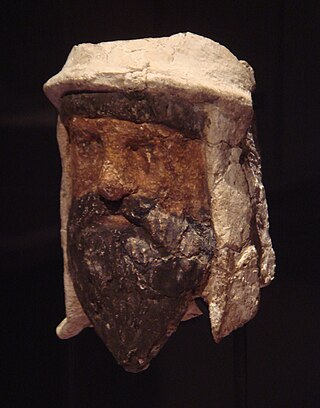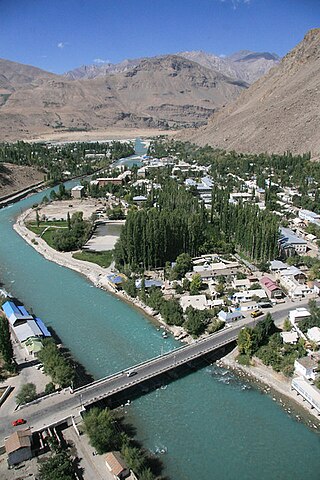
Suleiman Sharifi (born 1958) is a Tajikistani artist. A Member of the Union of Artists of Tajikistan, his works are held in museums and private collections of Tajikistan, Russia, Europe and Asia. [1]

Suleiman Sharifi (born 1958) is a Tajikistani artist. A Member of the Union of Artists of Tajikistan, his works are held in museums and private collections of Tajikistan, Russia, Europe and Asia. [1]

Tajikistan, officially the Republic of Tajikistan, is a landlocked country in Central Asia. Dushanbe is the capital and most populous city. Tajikistan is bordered by Afghanistan to the south, Uzbekistan to the west, Kyrgyzstan to the north, and China to the east. It is separated from Pakistan by Afghanistan's Wakhan Corridor.

Tajikistan harkens to the Samanid Empire (819–999). The Tajik people came under Russian rule in the 1860s. The Basmachi revolt broke out in the wake of the Russian Revolution of 1917 and was quelled in the early 1920s during the Russian Civil War. In 1924, Tajikistan became an Autonomous Soviet Socialist Republic of the Soviet Union, the Tajik ASSR, within Uzbekistan. In 1929, Tajikistan was made one of the component republics of the Soviet Union – Tajik Soviet Socialist Republic – and it kept that status until gaining independence 1991 after the dissolution of the Soviet Union.
The politics of Tajikistan nominally takes place in a framework of a presidential republic, whereby the President is both head of state and head of government, and of a multi-party system. Legislative power is vested in both the executive branch and the two chambers of parliament.

The economy of Tajikistan is dependent upon agriculture and services. Since independence, Tajikistan has gradually followed the path of transition economy, reforming its economic policies. With foreign revenue precariously dependent upon exports of cotton and aluminium, the economy is highly vulnerable to external shocks. Tajikistan's economy also incorporates a massive black market, primarily focused on the drug trade with Afghanistan. Heroin trafficking in Tajikistan is estimated to be equivalent to 30-50% of national GDP as of 2012.

Tajiks are a Persian-speaking Iranian ethnic group native to Central Asia, living primarily in Afghanistan, Tajikistan, and Uzbekistan. Tajiks are the largest ethnicity in Tajikistan, and the second-largest in Afghanistan and Uzbekistan. They speak varieties of Persian, a Western Iranian language. In Tajikistan, since the 1939 Soviet census, its small Pamiri and Yaghnobi ethnic groups are included as Tajiks. In China, the term is used to refer to its Pamiri ethnic groups, the Tajiks of Xinjiang, who speak the Eastern Iranian Pamiri languages. In Afghanistan, the Pamiris are counted as a separate ethnic group.

Dushanbe is the capital and largest city of Tajikistan. As of March 2024, Dushanbe had a population of 1,564,700, with this population being largely Tajik. Until 1929, the city was known in Russian as Dyushambe, and from 1929 to 1961 as Stalinabad, after Joseph Stalin. Dushanbe is located in the Gissar Valley, bounded by the Gissar Range in the north and east and the Babatag, Aktau, Rangontau and Karatau mountains in the south, and has an elevation of 750–930 m. The city is divided into four districts, all named after Persian historical figures: Ismail Samani, Avicenna, Ferdowsi, and Shah Mansur.

Emomali Sharip ulu Rahmon is a Tajik politician who has been serving as the 3rd President of Tajikistan since 16 November 1994. Previously he was the Chairman of the Supreme Assembly of Tajikistan, as the de facto head of state from 20 November 1992 to 16 November 1994. Since 18 March 1998, he has also served as the leader of the left-wing People's Democratic Party of Tajikistan, which dominates the Parliament of Tajikistan. On 30 September 1999, he was elected vice-president of the UN General Assembly for a one-year term.

Khorog is the capital of Gorno-Badakhshan, Tajikistan. It is also the capital of the Shughnon District of Gorno-Badakhshan. It has a population of 30,500.

Administratively, Tajikistan is divided into:

Khujand, sometimes spelled Khodjent or Chudzjand, and formerly known as Leninabad from 1936 to 1991, is the second-largest city of Tajikistan and the capital of Tajikistan's northernmost Sughd province.

Gorno-Badakhshan, officially the Badakhshan Mountainous Autonomous Region, is an autonomous region in eastern Tajikistan, in the Pamir Mountains. It makes up nearly forty-five percent of the country's land area but only two percent of its population.

The Tajikistan national football team represents Tajikistan in international football and is controlled by the Tajikistan Football Federation, the governing body for football in Tajikistan. Tajikistan's home ground is the Pamir Stadium in Dushanbe.

Bukharan Jews, in modern times called Bukharian Jews, are the Mizrahi Jewish sub-group of Central Asia that historically spoke Bukharian, a Judeo-Persian dialect of the Tajik language, in turn a variety of the Persian language. Their name comes from the former Central Asian Emirate of Bukhara, which once had a sizable Jewish population. Bukharan Jews are of Persian-Jewish ancestry, though they are considered one of the oldest ethno-religious groups of Central Asia and over the centuries developed their own distinct customs.

The Tajikistani Civil War, also known as the Tajik Civil War, began in May 1992 and ended in June 1997. Regional groups from the Garm and Gorno-Badakhshan regions of Tajikistan rose up against the newly formed government of President Rahmon Nabiyev, which was dominated by people from the Khujand and Kulob regions. The rebel groups were led by a combination of liberal democratic reformers and Islamists, who would later organize under the banner of the United Tajik Opposition. The government was supported by Russian military and border guards.

The Emirate of Bukhara was a Muslim polity in Central Asia that existed from 1785 to 1920 in what is now Uzbekistan, Tajikistan, Turkmenistan and Kazakhstan. It occupied the land between the Amu Darya and Syr Darya rivers, known formerly as Transoxiana. Its core territory was the fertile land along the lower Zarafshon river, and its urban centres were the ancient cities of Samarqand and the emirate's capital, Bukhara. It was contemporaneous with the Khanate of Khiva to the west, in Khwarazm, and the Khanate of Kokand to the east, in Fergana. In 1920, it ceased to exist with the establishment of the Bukharan People's Soviet Republic.

Tajikistan first participated at the Olympic Games as an independent nation in 1996, and has sent athletes to compete in every Summer Olympic Games since then. The nation has also competed at the Winter Olympics since 2002. To date, Andrei Drygin is one of two people ever to have represented Tajikistan at the Winter Olympic Games, being his country's sole competitor in 2002, 2006, and 2010.

This page shows the Tajikistan national football team's results in International Matches, as recognized by FIFA:

Visitors to Tajikistan must obtain a visa unless they are citizens of one of the visa-exempt countries, or citizens who may obtain a visa on arrival, or citizens eligible for an e-Visa.
The following is a list of state awards in Tajikistan. State awards include the orders, decorations, and medals.
The COVID-19 pandemic in Tajikistan is part of the worldwide pandemic of coronavirus disease 2019 caused by severe acute respiratory syndrome coronavirus 2. The virus was confirmed to have spread to Tajikistan when its index cases, in Dushanbe and Khujand, were confirmed on 30 April 2020.